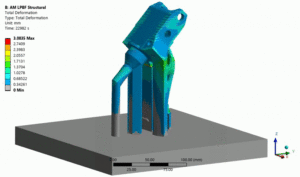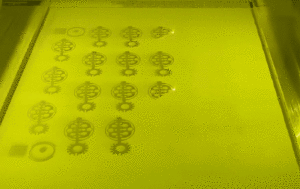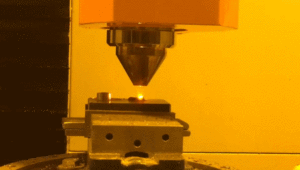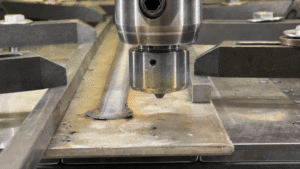Metal Additive Manufacturing Simulation using Ansys Workbench
Metal additive manufacturing (AM) has surged in popularity due to its ability to create both prototypes and final production parts. However, this cutting-edge technology comes with challenges, primarily related to thermal strains, part distortion, residual stresses, and build failures. These issues arise from the intense heat transfer involved during the manufacturing process. Fortunately, Ansys Workbench Additive provides a solution by simulating these processes to help manufacturers predict and resolve these problems, ensuring successful part creation without costly trial and error.
The Challenges of Metal Additive Manufacturing
The thermal dynamics of metal additive manufacturing can cause significant issues, such as:
- Part distortion: As heat is applied during production, thermal expansion and contraction can lead to deformation.
- Residual stresses: Unrelieved stress within the material can lead to fractures or failures during or after manufacturing.
- Costly build failures: Without accurate simulation, manufacturers may waste time and resources on failed builds.
What Metal Additive Manufacturing Processes Can Be Simulated with Ansys?
In this technology, a thin layer of metal powder is deposited, and a laser is then used to melt the metal powder into the shape of the cross-section of the part, fusing it to either the build plate or the previous layer. The build plate is then lowered, and another layer of powder is spread across the surface using a recoater blade. This process is repeated until the final layer is fused at the top of the part. Ansys Workbench Additive supports the simulation of multiple additive manufacturing processes, including:
1. Laser Powder Bed Fusion (LPBF)
Also known as Direct Metal Laser Sintering (DMLS), Selective Laser Melting (SLM), or Direct Metal Laser Melting (DMLM), LPBF is one of the most common methods in metal additive manufacturing. In this process, a laser melts metal powder layer by layer to form a solid part. Ansys simulates this process using a technique called element birth and death, which allows layers of elements to be activated at the melt temperature. This transient thermal analysis calculates how heat transfers through the material, helping predict outcomes like:
- Deformation: How the part may change shape during production.
- Residual stresses: The internal stresses that remain in the material after manufacturing.
Ansys simulates this LPBF process by activating entire layers of elements at the material melt temperature using a technique known as element birth and death. A transient thermal analysis is used to determine the global time-temperature history of the printing process as layers of elements are activated and heat is transferred via convection and conduction through the base plate. These temperature results are then fed into a Static Structural analysis where thermal strains can be calculated in order to determine the desired results such as deformation and residual stress.
Laser Powder Bed Fusion Source: National Centre for Additive Manufacturing (NCAM)
2. Directed Energy Deposition (DED)
Directed Energy Deposition (DED) uses a laser or electron beam to melt the material and add new layers, often creating larger parts compared to LPBF. The process is also referred to as Laser Engineered Net Shaping (LENS), Wire Arc Additive Manufacturing (WAAM), or Electron Beam Additive Manufacturing (EBAM).
Ansys takes DED simulation to the next level by reading G-code from the additive machine and activating clusters of elements that follow the tool path. This method enhances accuracy in predicting:
- Distortion: The effects of heat on the structure during sequential element activation.
- Residual stresses: Managing internal stress points that could affect part integrity.
The DED process often involves building larger parts and spending more time on each individual layer when compared to the LPBF process. Because of this, the assumption that an entire layer of elements can be activated at once does not necessarily hold true. For the DED process simulation, Ansys is capable of reading the G-code of the additive machine in order to create clusters of elements that follow the tool path. Ansys can then activate those elements sequentially at the melt temperature using the same birth and death technique mentioned earlier. The same combination of Transient Thermal and Static Structural analyses that are used for LPBF are also used for DED to predict part distortion and residual stresses.
Directed Energy Deposition Source: UT Dallas Comprehensive Advanced Manufacturing Lab
3. Additive Friction Stir Deposition (AFSD)
Ansys Workbench Additive can also simulate solid-state processes like Additive Friction Stir Deposition (AFSD), where material does not melt but instead plastically flows due to friction. Instead, feedstock is rotated and pressed into a substrate until friction causes the material to heat up and plastically flow onto the substrate. The way this is implemented using the Ansys Workbench Additive DED process is by activating the clusters of elements at the AFSD process temperature rather than at the material’s melt temperature. By adjusting the simulation parameters, Ansys can predict outcomes such as deformation and heat-induced effects without reaching the material’s melt temperature.
Additive Friction Stir Deposition Source: BYU Friction Stir Research Lab
Why Choose Ansys Workbench Additive for Metal AM Simulation?
To summarize, Ansys Workbench Additive is capable of simulating multiple metal additive manufacturing processes including LPBF, DED, and AFSD to predict temperatures, distortions, and residual stresses, ensuring that parts are printed successfully on the first attempt. Key benefits include:
- Accurate predictions: Prevent distortions, build failures, and residual stresses before production begins.
- Cost and time savings: Reduce the need for trial and error in manufacturing.
- Versatility: Simulate multiple AM processes, including LPBF, DED, and AFSD.
Ready to Overcome Metal AM Challenges?
By using Ansys Workbench Additive, manufacturers can streamline their metal additive manufacturing processes and ensure successful part production on the first attempt. Ready to optimize your production? We invite you to join our two-part webinar series, focusing on how Ansys Workbench can optimize metal additive manufacturing processes. This series is designed for professionals looking to improve production accuracy and efficiency through advanced simulation techniques.
Webinar 1: Laser Powder Bed Fusion (LPBF) Simulation
In the first session, we’ll focus on simulating the LPBF process, where we’ll cover:
- Thermal analysis techniques: Prevent part distortion and manage residual stresses.
- Element birth and death method: Learn how to simulate layer-by-layer melting for accurate part production.
- Live demo: Watch Ansys Workbench in action with real-world LPBF simulation examples.
Date: Wednesday, Oct 23, 2024
Time: 9am – 9:45am (CDT)
Webinar 2: Directed Energy Deposition (DED) and Additive Friction Stir Deposition (AFSD) Simulation
The second session will dive into simulating DED and AFSD processes, including:
- G-code driven simulation: See how Ansys reads machine paths for precise sequential element activation in DED.
- Solid-state AFSD simulation: Understand the nuances of simulating material flow without melting.
- Live demo: Get an inside look at how Ansys handles these complex additive manufacturing processes.
Date: Friday, Nov 1, 2024
Time: 9am – 9:45am (CDT)
Don’t Miss Out!
Both webinars will include live demonstrations, expert insights, and Q&A sessions. Whether you’re looking to improve LPBF accuracy or explore DED and AFSD simulations, this series will provide the tools you need to succeed.
Register now to reserve your spot for one or both sessions!




